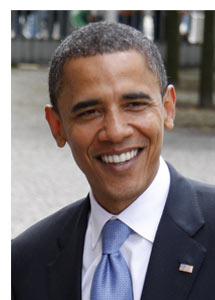 This Valentine’s Day, the HIV community got a love letter from Washington: increased funding levels for HIV/AIDS in President Obama’s proposed FY 2012 budget.
This Valentine’s Day, the HIV community got a love letter from Washington: increased funding levels for HIV/AIDS in President Obama’s proposed FY 2012 budget.In a moment when Republicans are screaming to slash funding and the President has committed to a five-year freeze in non-defense discretionary spending, few of us were hopeful that the President would up the ante on HIV/AIDS spending--domestically or globally.
But the proposed FY 2012 budget seems an indication that President Barack Obama and his top people in government believe in continued support for the fight against HIV/AIDS. Which is a good thing not only because it will save lots of lives but also because it will save lots of dollars and prevent our generation from handing a ballooning AIDS epidemic (and its ever-swelling price tag) to the next. Especially in economically restricted times, there are certain things that deserve greater investments because those investments ultimately lead to cost savings. HIV/AIDS is a prime example. We either pay more now, or pay a lot more later.
A sampling of the figures in the president’s budget include: an $88 million dollar increase for The Ryan White CARE Act above 2010 level (bringing the total to $2.4 billion), an $80 million increase ($105 million with monies previously requested) for the AIDS Drug Assistance Program (bringing the total to $940 million for FY 2012) and $74 million for AIDS research. $1.3 billion has been allocated for The Global Fund to Fight TB, Malaria and HIV/AIDS.
To read a more specific breakdown of President Obama’s proposed FY 2012 budget as it pertains to HIV/AIDS, click here.
Now, lest it seem like I’m painting too rosy a picture, remember a couple of things: 1) funding for the President’s Emergency Plan for AIDS Relief (PEPFAR)--our nation’s great gift to the fight against global AIDS--was nearly flat funded. That is likely to mean that we will lose ground on the international front, at a moment when an uptick in funding could have meant exponential gains, and that means more babies born with HIV, more people unable to access lifesaving care and treatment and more deaths, 2) there’s no telling what’s going to happen to the President’s proposed FY 2012 budget once it goes to Congress--especially a GOP-led House that is calling to cut discretionary funding for the remainder of FY 2011 to the tune of $100 billion dollars (yes, I am saying this out loud using the Dr. Evil voice from Austin Powers).
Therein lies the rub. Ever since the recession set in, the HIV community’s been in a quandary: we don’t want to seem ungrateful for the additional, specialized funding that continues to flow our way and yet we also need to advocate for the Full Monty of monies needed to stop AIDS dead in its tracks. While we celebrate budget increases, we also face the reality that thousands of people living with HIV face access to care issues in the United States. (On the press call with the White House this morning, I asked whether the monies allocated for ADAP were based on the number of people on waiting lists or whether they also took into account the fact that changes in eligibility requirements for ADAP have pushed many who would have been on a waiting list into the hinterland of no care and no plan. Still waiting for a more specific answer...). Getting to 2014--when the Affordable Care Act kicks in fully and addresses many of the needs of people with HIV--without having Americans face a crisis of care will be trickier than some expect.
I understand why there is grousing that even these increases aren’t enough and I know that the increase could be academic if the budget gets shredded in Congress.
But we should acknowledge our president is sending a clear signal that he supports the fight against HIV/AIDS. That fact should not be lost amidst the budget debates and green-visored-number-crunching. Leadership from on high is an essential element in a community’s ability to have its concerns addressed.
Remember when we had a president who wouldn’t even say “AIDS”?
Also consider President Obama has fueled the fight against HIV/AIDS while proposing cuts that must cause him pain such as community development and heating assistance for the poor. Giving more money to HIV is an indication that he’s serious about ensuring our fight against HIV/AIDS is, as Dr. Tom Frieden, head of the Centers for Disease Control and Prevention (CDC), put it a “winnable battle.”
One of the hardest things for me about advocating for HIV/AIDS is that I know, ultimately, I am being selfish. I am fighting for my survival and the survival for people like me in a world where doing so successfully means lobbying for support for your crisis--as we are witnessing--at the expense of support for others in need. I don’t feel very good about that.
That said, I am gathered with many others in DC to advocate on behalf of people, like myself, who are living with HIV. And the name of the game is to justify why our community should be helped. When there are many social ills, diseases and broken systems (like education) that need addressing, all equally deserving help, one way to triage needs is to choose those where investments will have the greatest good for the greatest number of people.
The economics of investing in the fight against HIV are clear (read my take on them in my Huffington Post blog.) There’s another good reason to invest in HIV/AIDS right now: we have a National HIV/AIDS Strategy, endorsed by community leaders and much of the community itself. We have what I think is a really sound blueprint for wrangling the beast of AIDS to the ground--now we just need adequate resources to do so. HIV/AIDS is preventable and treatable. And when we spend more money to educate, test and link people to care in ways that are effective, we see measurable and dramatic results. We also have the world headed our way in the summer of 2012 and we surely want, as a nation, to set the gold standard for addressing the pandemic. Given that the HIV infection rates in the District of Columbia rival those of sub-Saharan African countries, we’ll have a lot of explaining to do if we have not managed to better address HIV in our nation’s capital when the world comes here to discuss the fight against HIV.
With a sound strategy and the right, strategic investments, lots of inter-departmental cooperation as well as the support of the community, state governments and the private sector, we can make huge steps against the domestic epidemic and have a wonderful story to tell the world in 2012.
Chris Collins, vice president and director of public policy at the Foundation for AIDS Research (amfAR; I am a board member for purposes of disclosure) wrote two great policy briefs on AIDS funding and you can read them here and here. Even if you’re not a policy wonk, they’re really eye-opening!
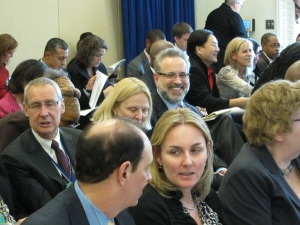
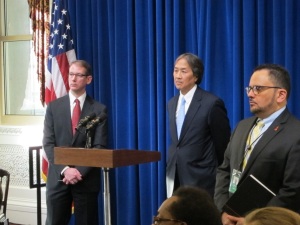
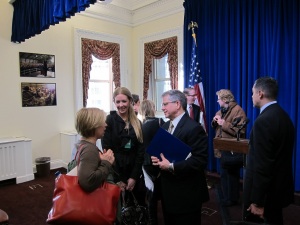 Members of the HIV community gathered at the White House yesterday to hear Jeffrey Crowley, Director of the Office of National AIDS Policy and Dr. Howard Koh, Assistant Secretary of Health, present the news that President Obama is serious about stopping HIV/AIDS. The photos on the right show the meeting.
Members of the HIV community gathered at the White House yesterday to hear Jeffrey Crowley, Director of the Office of National AIDS Policy and Dr. Howard Koh, Assistant Secretary of Health, present the news that President Obama is serious about stopping HIV/AIDS. The photos on the right show the meeting.Points made at yesterday’s meeting were reiterated this morning on a press call, hosted by Jeffrey Crowley and White House Domestic Policy Council Director Melody Barnes. When asked whether the president’s apparent commitment to HIV applies to appropriations for 2011 as well, Barnes said, “Our [FY 2012] budget stands as a very clear marker for the things we see important.” She pointed out that even at a time of great fiscal challenge, “we were able to stand strong” in defense of HIV/AIDS funding and suggested that proposed spending levels for HIV in 2012 were to be read as clear signs of President Obama’s ongoing dedication to a community that is “struggling with unmet needs.”
It is thrilling to think that we have the support of our nation’s leadership on this issue.
Now, the real question is: will Congress feel the same way?
Our current POZ cover story showcases the plight of AIDS activists in Ohio fighting for funding to keep people with HIV connected to care--in the district of Speaker of the House John Boehner. The story speaks to a more general need for Congressional leadership on the issue of funding for HIV/AIDS.
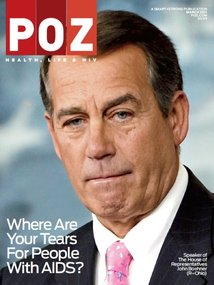 POZ’s cover asks Speaker Boehner: Where are your tears for people with HIV/AIDS? We hope he will read this story and weep--for it portends a much bigger crisis to come soon. One that will be amplified by looming FY 2011 budget cuts. Budget cuts that he can influence. In contrast to the president, the GOP leadership, specifically Speaker Boehner have proposed slashing funding for HIV programs in DC, the Centers for Disease Control and Prevention and the National Institutes of Health.
POZ’s cover asks Speaker Boehner: Where are your tears for people with HIV/AIDS? We hope he will read this story and weep--for it portends a much bigger crisis to come soon. One that will be amplified by looming FY 2011 budget cuts. Budget cuts that he can influence. In contrast to the president, the GOP leadership, specifically Speaker Boehner have proposed slashing funding for HIV programs in DC, the Centers for Disease Control and Prevention and the National Institutes of Health.Indeed, without the compassion and commitment of the GOP leadership in Congress, Obama’s sweetest of valentines may be returned.
Photos of meeting at The White House courtesy of AIDS.gov/Miguel Gomez.







4 Comments
4 Comments